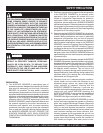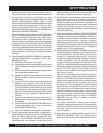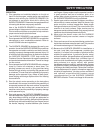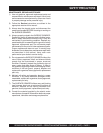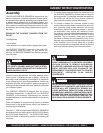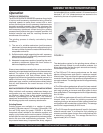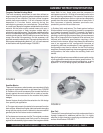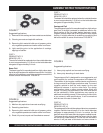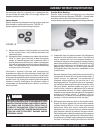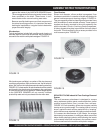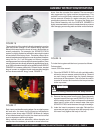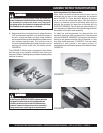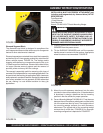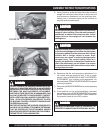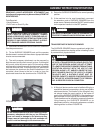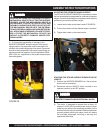
SFG10E ELECTRIC SURFACE GRINDER — OPERATION AND PARTS MANUAL — REV. #1 (07/16/07) — PAGE 16
Scarifier Block Bushing
Scarifier block bushings are designed to be discarded
whenever the flails are replaced. FIGURE 11. Normal wear
should be uniform about the bushing circumference.
Uneven bushing wear would suggest the following problems:
FIGURE 11
1) Inadequate free play exists between the flails/spacer
washers and the scarifier block case. If the flails and
spacer washers do not have complete freedom of
movement, they will not be capable of properly rotating
about the scarifier block bushing. The result is bushing
wear usually confined to two locations that are 180
degrees apart. Variances in flail and spacer washer
thicknesses affect free play when assembled on the
scarifier block.
Because free play is also created during the scarifying
process due to actual flail and spacer washer wear, a
certain amount of “tightness” can sometimes be
tolerated without affecting the service life of the
bushings and flails. The specific amount of “tightness”
can usually be determined through trial and error. If the
flails and spacer washers appear too tight on the
scarifier block, remove an appropriate flail or washer
and reassemble the block. If a short, operational test
indicates normal component wear patterns, the apparent
problem has been solved. A general rule for
consideration: it is better to have the flails and spacer
washers a “little too loose than a little too tight”.
2) Mixing both worn and new flails on the scarifier block.
Proper flail action against the work surface material
requires that the flails be of the same approximate
dimensions. Flails with various inside and outside
dimensions will not impact the work surface material
with the same intensity and deliver the same results.
Flail bushing wear is directly proportional to the amount
of force it must supply against each individual flail. When
a bushing can no longer supply adequate force against
the flails, it will break, allowing the flails to be hurdled
ASSEMBLY INSTRUCTIONS/OPERATIONS
FIGURE 10
DANGERDANGER
DANGERDANGER
DANGER
USE ONLY FACTORY SUPPLIED SPACER WASHERS
ON THE SCARIFIER BLOCK. OTHER WASHER TYPES
AND/OR CONFIGURATIONS CAN PRODUCE ABNOR-
MAL WEAR AND ELONGATION, RESULTING IN
COMPLETE SEPARATION FROM THE SCARIFIER
BLOCK. INADVERTENT SPACER WASHER SEPARA-
TION CAN LEAD TO PROPERTY DAMAGE AND/OR
PERSONAL INJURY.
that particular area. As a general rule, a pentagonal flail
can be utilized until body wear will no longer support the
tungsten carbide inserts.
Spacer Washer
Spacer washers are stamped from high carbon steel and
heat-treated for additional service life. FIGURE 10.
Spacer washers serve the following functions:
1) Reduces the number of flails required to be mounted
on the scarifier block, thus reducing purchase and
operational costs.
2) Arrange the flails in a sequence or pattern that minimize
“blind” or “open” spots. Normally, at least one spacer
washer is inserted between two consecutive flails. A
scarifier block set up with only star, beam or pentagonal
flails will not penetrate the work surface at satisfactory
rates. This configuration will minimize the hammering
or impact action of the flails.
Variances in material thickness and manufacturing
processes can affect the final thickness of both flails and
spacer washers. Because of this occurrence, trial and error
is important for assembling flails and spacer washer on the
scarifier block. By mixing and matching flails and spacer
washers of specific thicknesses, the required number of
components can be assembled on a block in a minimum
amount of time.



